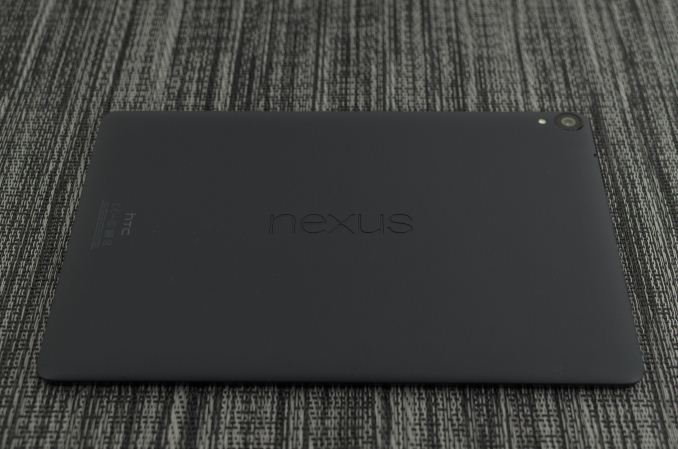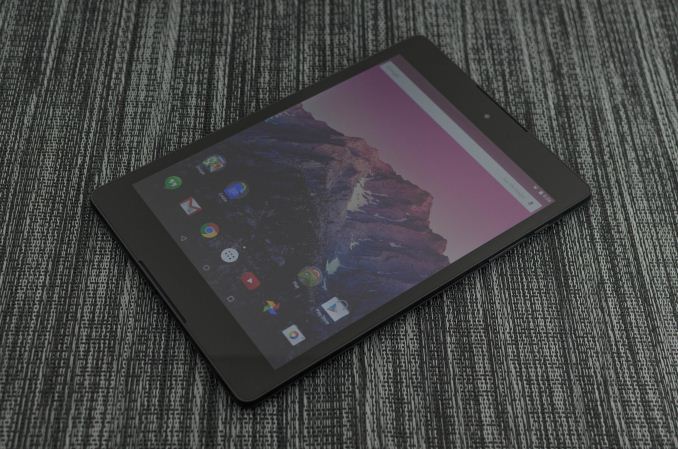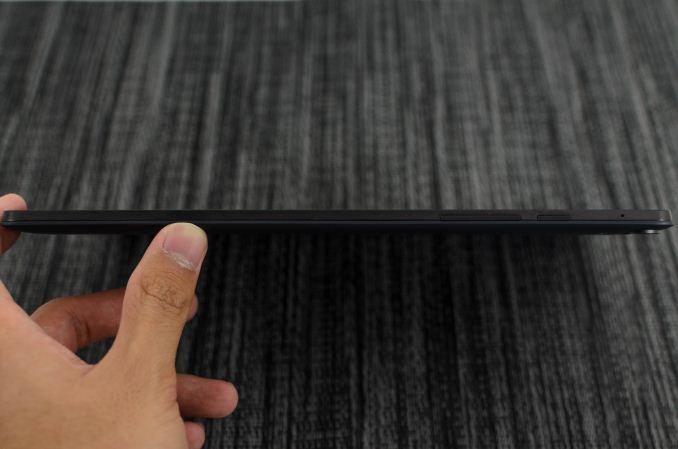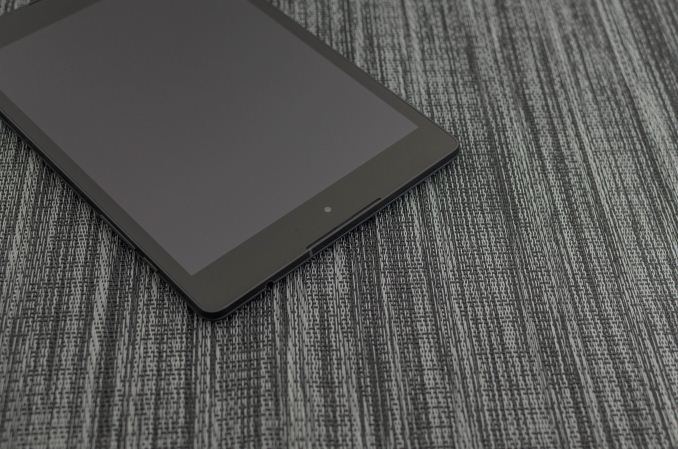Google Nexus 9: Preliminary Findings
by Joshua Ho on November 3, 2014 1:00 PM EST
For a few years now, Google has had a generally consistent tablet strategy. Instead of chasing after the ~10 inch tablet segment and focusing upon the high end, we’ve seen tablets closer to the ~7 inch display size at extremely low cost. While this has been an immensely successful strategy in driving hardware adoption, the formfactor made it possible for the tablet to be closer to a large phone than a small tablet. The flexibility of Android’s scaling system meant that an app designed for a phone worked acceptably well for a small tablet, even if the space efficiency was a bit poor. There’s no question that the Nexus 7 (2013) was and still is a great tablet, but even now it’s obvious that there’s a dearth of applications designed specifically for the larger display. The other issue is that of cost. With the Nexus 7 line, Google managed to integrate an incredible amount of hardware into a tablet priced well below the ~500 USD price point that the original iPad established. This is great for the consumer and no doubt great for Google, but the Nexus 7 line was good enough that there wasn’t much in the way of competition.
This brings us to the Nexus 9, Google’s attempt at changing the Android tablet space. From the start, this device seems to be intent on pushing the Android tablet to a more premium segment. Rather than a purely cost-optimized polymer design, we see the addition of an aluminum ring that runs around the side of the device, which definitely helps with in-hand feel. The tablet itself seems to have high-end aspirations as the launch platform for NVIDIA’s Tegra K1-64, which has two Denver CPU cores rather than the traditional 4+1 Cortex A15 setup, along with dual front-facing speakers and a large 9” display with 4:3 aspect ratio. I’ve included the basic specs in a spec sheet below, to avoid spending too much time going over the basics.
| Nexus 9 | |
| SoC | 2.3GHz 64-bit dual core Tegra K1 Denver SoC |
| RAM/NAND | 2GB LPDDR3 + 16/32GB NAND |
| Display | 8.9" 2048x1536 IPS LCD |
| Network | WiFi only or 2G / 3G / 4G LTE SKU |
| Dimensions | 153.68 x 228.25 x 7.95mm, 425g WiFi, 436g LTE |
| Camera | 8MP Rear Facing (IMX219) with F/2.4 aperture, 1.6MP FFC (OV9760) |
| Battery | 6700 mAh (25.46 Whr) |
| OS | Android 5.0 Lollipop |
| Connectivity | 802.11a/b/g/n/ac + BT 4.1, USB2.0, GPS/GNSS, NFC |
Unfortunately, in the case of the Nexus 9 while we can make some early observations the version of firmware that we received dates was built on August 29th, and in the time since it’s quite likely that there have been significant changes in all directions. We still don't have a newer build, so all the tests will be done on older firmware. The full review will have final numbers as it will be done using shipping firmware.
At any rate, the hardware of the Nexus 9 definitely fits the bill of a premium tablet. While for the most part every Nexus device in the past year has shared the same industrial and material design elements, HTC seems to have added a few extra touches to differentiate this product from other Nexus devices. The most obvious and prominent of these touches is the metal ring, which has a brushed texture similar to what we saw on the M8.
There are also dual front-facing speakers that flank the display, which are definitely great for video and music content when compared to a single speaker on the bottom or back of the device. However, for the most part the design is very much a Nexus device with its minimalistic design and soft-touch plastic back cover.













146 Comments
View All Comments
speculatrix - Monday, November 3, 2014 - link
Quite often Nexus devices have a close sibling from the same manufacturer but with extra hardware niceties, such as gaining a memory card slot, different or removable battery, USB on the go etc.So it will be interesting to see if HTC come out with a very similar table to this Nex9 but with a memory car slot and some premium features?
arkhamasylum87 - Monday, November 3, 2014 - link
Can you guys do a comparison article between apple a8x, tegra k1 and intel core m ? would love to understand your thoughts on the tablet/hybrid market as a whole and if there is a potential here.varad - Wednesday, November 5, 2014 - link
+1agoyal - Monday, November 3, 2014 - link
I think the real question is, how will it fair in comparison with A57 which should be coming soon!!darkich - Tuesday, November 4, 2014 - link
The 20nm 1.9GHz A57 is already out in the Galaxy Note 4.Scores around 1250 in single core Geekbench.
But power draw in the octa core setup should be incredibly low considering that the 20nm Exynos 5430(Cortex A15/Galaxy Alpha) doesn't even cross 3W under maximum load!
Also,if the rumors are true that Snapdragon 810 will have it clocked at 2.7GHz, the end result should be quite incredible.
NotLupus - Monday, November 3, 2014 - link
I bought a Nexus 7 2013 from Walmart last year just as it was released. Battery life was about 6 hours of screen time with low brightness and no background syncing, doing mostly web browsing or local video playback. It was nowhere near Anandtech's 12 hours, not even the advertised 9 hours. Ever since then I'm skeptical battery life claims for android devices. This Nexus 9 review sample was probably cherry-picked.agoyal - Monday, November 3, 2014 - link
I have had similar experience with android devices, I have owned nexus 7 2013,LG G pad 8.3 and Galaxy pro tab 10.1. Had IPad Air and the battery would last a long time mostly with web browsing, much more than the review sites.poohbear - Monday, November 3, 2014 - link
between my 5.7" Note 3 phablet, my 13" ultrabook, and my 27" desktop beast, what exactly do u need a tablet for? All my friends that bought one say it just sits there unused. Seems like a niche market or just a gimmick.WarlockOfOz - Tuesday, November 4, 2014 - link
One solution to your question: replace the phablet with a small, basic phone plus a 8" wide screen tablet and you get something that's more convenient for actual phone calls, provides more screen space for everything else, has a lower total cost and can still be carried in your pockets. Not sure about tablets that need bags myself, but lots of other people seem to like them.darkich - Tuesday, November 4, 2014 - link
I disagree that 8" wide screen tablet is more convenient than a 5.7" palmtop (I happen to own both, palmtop being the Galaxy Note 3).The Note 3 is simply much easier to hold. And the screen is still perfectly big for reading and even movies while laying in bed.
Handling Web pages and gaming is also much easier.
While my tablet is perfectly okay for what it is, I find it using it mostly when my Note 3 is charging.
So I tend to agree with the above post. Phablets (or palmtops as I prefer to call them) are the reason for tablet market stagnation, and are rightfully booming right now.
Just look at Apple's reaction if you need further evidence - neutering the iPad mini a release of the iPhone 6 plus.